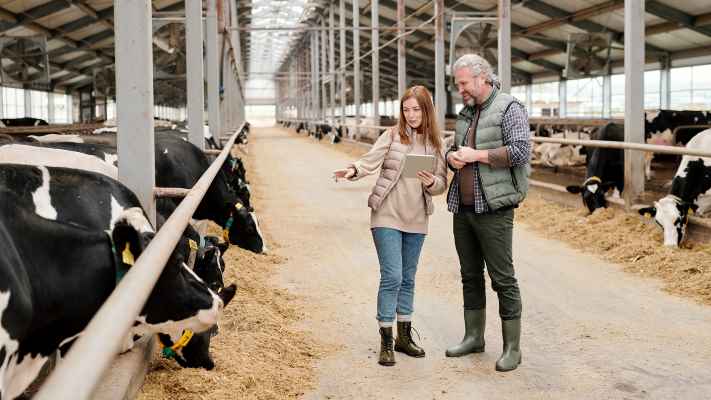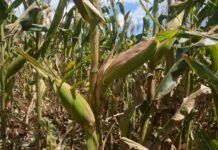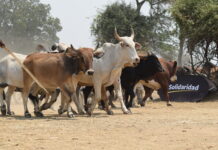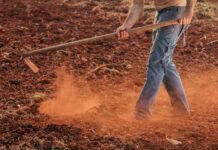Faced with tighter margins and the growing demand for milk products globally, today’s dairy industry is trending towards farms with larger, high performance herds. This means not only more complex operations, but also increased scrutiny on a wide range of environmental and socio-cultural issues: challenging with manure waste and its impact on soil, water and air quality, concerns about greenhouse gas emissions, or concerns about the use of antibiotics, to name a few. For farm managers, it’s not just low milk prices and high feed costs causing headaches. Today’s landscape is challenging on a whole new level, demanding new skills along with new levels of efficiency. To meet the challenge – to manage the complexity, keep their operations profitable, and fulfill the growing list of requirements and demands – farmers are turning to smart technologies for help. And it’s making a difference.
Smart farming – the new normal
Dr. Beate Maassen-Francke is Product Manager Farm Management Software at GEA, being a global leader in the dairy industry technology and an early mover in smart dairy farming solutions. With over 22 years of experience in the industry, she’s been there to see smart dairy farming take root. “I remember the feeding computer Codatron 80, one of the first ‘smart’ farming solutions back in the 90s,” she recalls. Today, according to a recent German Bitkom study almost 1 in 2 farms in Germany for example are using intelligent feeding systems and almost as many are using agricultural apps for smartphones or tablets. 21% of dairy farms in Germany already use milking robots, with demand growing around the world. And according to the latest study from Dutch ABN AMRO bank, the worldwide market for agricultural robots can double in size in 5 years’ time. “Optimal herd management on the farm has now become one of the most important success factors for modern and sustainable livestock farming,” says Maassen-Francke. And more and more often today, optimal herd management means relying on smart technologies: sensors, robots, digital tools and software.
Better work for farmers
Effective time management is a critical success factor for today’s dairy farmers. “To get through their to-do list for the day, herd managers absolutely need to be more time-independent,” says Maassen-Francke. “They need to be informed in real time on where and when to intervene.” Combining sensors and software with mobile devices allows farmers the flexibility of not having to be in the barn or in front of the PC around the clock. Moreover, mobile devices allow all employees across the farm to stay up to date and to coordinate more effectively.
The increasingly IT-based nature of work on the farm may be benefitting the industry in other ways, too. Dr. Ute Müller from the University of Bonn’s Institute of Animal Sciences sees smart technologies making agriculture attractive again to younger people. “It has been difficult to recruit talent in rural regions because of associations with herd management as strenuous and generally outdated method of work. But this is fortunately changing,” she says. “In my daily work with my students, I see them getting excited about combining their practical and scientific knowledge with the power of IT to manage the complexity of modern-day dairy operations. This is an important element that we shouldn’t underestimate in terms of the long-term sustainability of agriculture and its required industry itself.”
Better health for cows
The “big data” generated by today’s dairy farms is also improving animal health. With GEA’s CowScout system, on the market since 2012, it is possible to track each cow´s activity data, such as lying and eating times for example. With its heat detection feature, the CowScout also provides data on optimum time for insemination. The CowScout sensors continuously measure the cow´s behavior – 24/7 every day in the year – CowScout generates an alert if the cow´s behavior deviates from her usual activity patterns, comparing her behavior to the previous weeks rolling average. A new optional positioning function allows for faster locating of cows and thus immediate action.
Another example is GEA’s DairyMilk M6850 cell count sensor, which uses patented sensor-based technology to measure somatic cell count classes in milk for earlier detection of mastitis. By analyzing milk at each udder quarter individually, the sensor gives farmers a new level of early detection capability to protect the health of their herds. “Real-time data and analysis allow managers and veterinarians to intervene earlier with targeted action so cows can recover quicker from illness and require less antibiotics,” says Maassen-Francke.
Also GEA’s feeding systems support farmers in their feed management and feeding strategy, which plays a very important role for high-performance cows. With DairyNet, a precised control and programming of feeding stations in the barn and in the milking robot including group management, different rations, feeding ingredients etc. is possible. The herd management software can show at a glance, where to improve the feeding strategy which affects not only the better health of the herd but also the farm’s feed costs. This precision feeding conserves the resources in many respects.
Making data smart
Especially on large farms, using sensor technologies with 24/7 monitoring capability generates huge amounts of data. As in any other industry today, a system is only “smart” if it can manage the flood of data effectively. That’s where the software comes in. So what is the key to good herd and farm management software?
“It’s important to understand that farm managers don’t want to see data, they want to see information,” says Maassen-Francke, who recently oversaw the launch of GEA’s new DairyNet herd and farm management software in Germany. “They want to see where they can improve processes and strategies, where they can improve animal welfare, where they can save on resources and costs; they want to see the key figures at a glance, customized to their needs.” Developed and tested together with international dairy producers, DairyNet features a user-friendly interface with graphics and diagrams depicted visually and tailored to the individual needs of the farm.
While sensors, smartphones and software are opening up all manner of new possibilities, they also increase a farm’s dependence on fast, robust connectivity. “This is a potential limiting factor, because especially in rural areas all over the world, network coverage – with the kind of security and transmission rates required by smart farms – is not yet complete in most of the cases,” says Maassen-Francke. GEA’s answer is DairyNet Box, essentially a local server that allows the DairyNet system to be installed locally to secure operating processes and ensure fast response times on site.
“Ultimately, the job of a good herd management software is to empower dairy farmers take full advantage of the opportunities this digital transformation has to offer.”
– Dr. Beate Maassen-Francke, Product manager Farm Management Software at GEA
Changing the game
Smart technologies are not just making familiar processes easier, faster and more efficient, they’re also opening the door to brand new territory. To explore this potential, GEA takes part in critical dairy research with governments and world-renowned institutes, engaging with students and entrepreneurs to mine next-generation solutions. GEA’s AutoDry project offers an example of the milking technology industry joining forces with agricultural scientists to rethink the use of antibiotics.
Initiated in 2015 as a joint project between GEA and the University of Bonn, AutoDry set out to change the way cows are milked in their last phase of lactation before the dry period, which is 6-8 weeks before the expected calving date. Conventionally, cows are often administered an antibiotic treatment at the start of the dry period because the abrupt cessation of milking increases udder pressure and the risk of mastitis infections. The goal of AutoDry was to develop a software that could gradually reduce udder emptying, i.e. milk yield, in the period before dry off to avoid abrupt cessation. Based on research conducted at the University of Bonn’s Campus Frankenforst test farm, GEA succeeded in developing milking control software that helps to remove the milking cluster earlier and earlier in the last days before drying off. “This provides an automated way to ‘wean’ the cow down to a significantly lower daily milk yield and initiate involution, the regression of the mammary gland tissue, before the actual dry period starts,” says Müller, who led the University of Bonn research team for this project.
The software, which monitors absolute milk quantity rather than milk flow rate, is the first software of its kind that allows farmers to automate the initiation of involution. “Currently we are testing the software on larger farms to see how the changed milking control affects the routine work of drying off the cows,” says Beate Maassen-Francke. “This includes multiple optimization tests with other research partners before the patented software is ready for market.”
The results of the research farms so far show promise. “The software achieved an effective reduction in the milk yield of the cows before drying off. No cases of mastitis were recorded, and the average cell count was well below the limit,” says Müller. “So not only is the automated reduction gentler on the cow, but drying off can be done without antibiotics.”
“I believe this new milking control software will initiate a rethink in dairy farming.”
– Dr. Ute Müller, Institute of Animal Sciences, University of Bonn
Health, happiness … and sustainability
Whether they’re shaking up the industry or making age-old processes faster and more efficient, smart technologies are empowering dairy farmers to rise to the many challenges they face today – helping them stay profitable, attract young talent, ensure herd health, reduce resource consumption, waste and even GHG emissions. “We’re seeing these technologies make a difference because, most importantly, they’re enhancing the farmer experience and improving animal health and happiness, which is really the foundation for an efficient, cost-effective dairy business,” says Maassen-Francke. “It’s also the foundation for a sustainable dairy business. As an example, scientists in Switzerland recently found out, that cows produce less methane as they get older. So if we can keep them healthy and productive longer, we’re not only conserving the farm’s living resources, farms can improve their climate footprint as well.”








